Friday, June 16 2023. It is the ‘day of electrohypersensitivity’ (EHS). I’m driving from Cologne, Germany, to the annual EHS meeting in Rièzes, Belgium, near the French border. I still have a three-hour car ride ahead of me. There are no train stations or hotels nearby, since the EHS gathering takes place in a remote place with as little electrosmog as possible. The camp site in Rièzes, I was told, is almost a ‘white zone’ with very little wireless communication signals and electromagnetic waves in the air. Unfortunately, the camping car I had rented through a private booking platform broke down the day before my trip. Therefore, I am now driving a brand-new rental car. The front display BMW Touring worries me. I will be a guest at the EHS gathering. Arriving in their carefully chosen signal-free campsite in a car full of wireless technology might not be the best idea. But it was a ‘take it or leave it’ choice and I chose to go.
When I arrive in Rièzes around 10 pm, the sun has already set. I am grateful that the organisers have marked the way to the camp with yellow signposts. After I have parked at the entrance of the mobile home camping area, I am surprised that I still have a weak mobile signal in the parking area and can receive text messages via online messenger services. I send some last messages and switch off the phone. Participants of the annual EHS meeting are asked to leave their mobile devices in their cars. As EHS people are often also vulnerable to chemicals, we are asked to not use sun lotion, but to protect ourselves from the sun with hats and long sleeves. Multiple chemical sensitivity (MCS) and EHS are both described as idiopathic environmental intolerances (IEI) – “denoting a disease or condition the cause of which is not known or that arises spontaneously” (Oxford University Press 2010) from Greek ἴδιος idios “one’s own” and πάθος pathos “suffering”, idiopathy meaning approximately “a disease of its own kind” (‘Idiopathic Disease’ 2023).
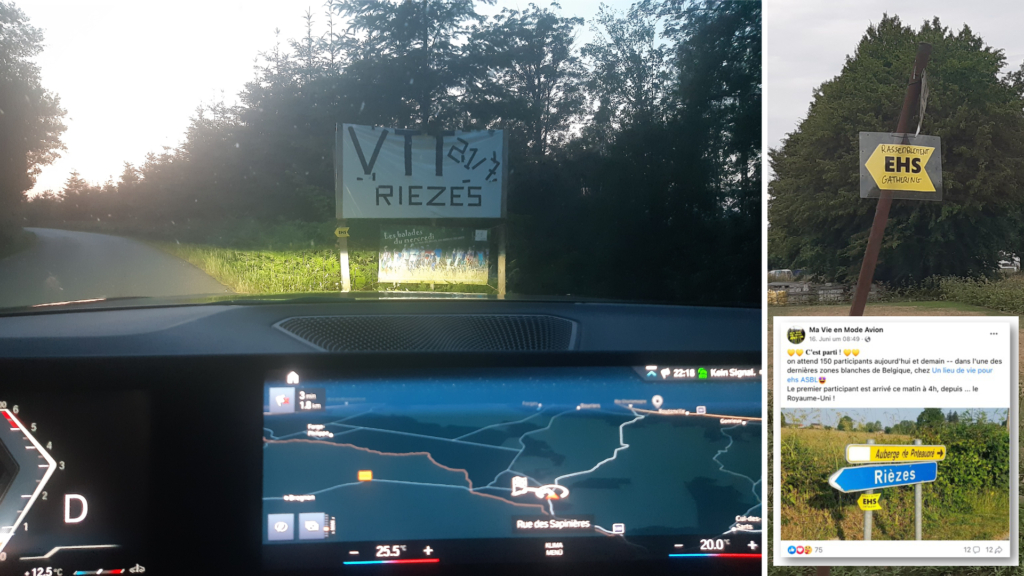
Yellow signs guide the participants to the White Zone in Rièzes, BE (also shown in a social media post by the organisers).
June 16 – arrival and first encounters
While there is still some daylight, I quickly prepare the back of my open BMW trunk so that I can sleep there. Then I look around. I’m standing on a mewed field. It’s a lovely place. The birds seem very loud. Next to me, some other participants have parked their camping cars and caravans (I did not count, but I would guess there about a dozen camping cars). Behind a little ditch, I see tents (maybe two dozen). On my way towards the tents, I meet Etienne* with a “Team” badge around his neck. Before I have time to ask questions, he tells me that he’s part of a legislation initiative in France aimed to protect people better against environmental pollution.
As we walk, we meet Marianne*. She walks with walking aids which looks quite difficult on the uneven grass. She introduces herself as the initiator of the world EHS day on June 16. The next day, during the meeting she is selling yellow T-Shirts at the associations’ stand, which some people are already wearing during the meeting. On their chests is a heart printed in black with a French inscription: “World EHS Day. Journée mondiale d’intolérance à la pollution electromagnétique 16 Juin”.
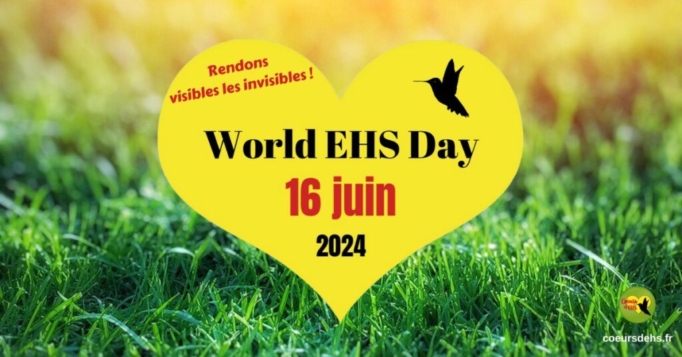
World EHS Day coeursdehs.fr.
At the entrance to the meeting area, I meet Eric* who is one of the main organisers and will also lead us through the coming two days as a talented moderator. He’s in a good mood. 150 participants have registered. There are attendants from nine different European countries. He tells me what will happen the next day: ‘There will be a wake-up call at eight since some people don’t have an alarm with them. The meeting will start at nine.’ The preparations went very well, he says. They had many helping hands, all volunteers. I look around. Everything is neatly set up. At this time, it’s calm in the camp. Most attendees are already in their campers or tents. Eric has told me that the gathering aims to generate positive energy and foster collective action. Yet, this won’t be a party weekend. Most people suffering from EHS are in bad health. For many of them, leaving their homes and travelling to the camp is very exhausting. As Clémence*, an attendee from France, tells me later, mobile communication antennas are installed everywhere along European highways.
June 17: first day in the ‘white’ meeting zone
It is already the second annual meeting of European EHS in Rièzes. The meeting is very well prepared. Food is delivered by a catering service and kept in a cooling car. The house in the meeting area has no running water so that the organisers have put up three chemical toilets and two places with dry toilets (also suitable for people sensitive to chemicals), clean bottled water and canisters for drinking and brushing teeth as well as water tanks where we can wash our hands. Instead of a shower, there is a little water stream next to the garden. Someone has volunteered to empty the dry toilets regularly. Quite remarkable commitments.
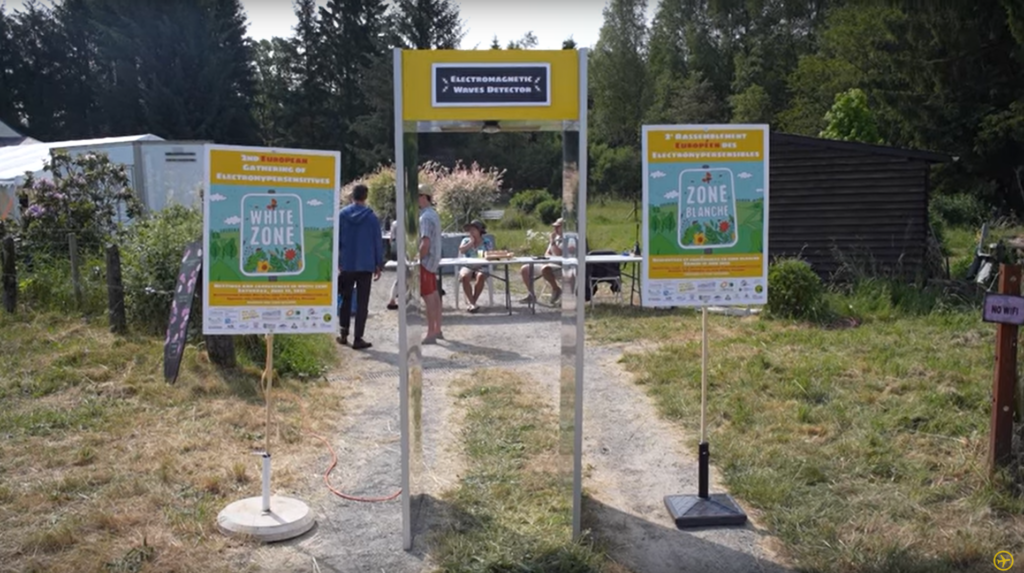
The entrance to the conference site with an EM-wave-detecting gate. Source aftermovie by Ma Vie en Mode Avion.
Where the camping, parking and meeting areas meet, the organisers have created a real entrance, including a gate-like, silver-shiny structure for detecting electromagnetic waves. When you walk through, it makes a sound. “Don’t stand there too long,” warns a co-participant, when I stop under the detector to listen to the electronic sound. Right and left to the gate, posters show the meeting programme with parallel streams of presentations in French and English!
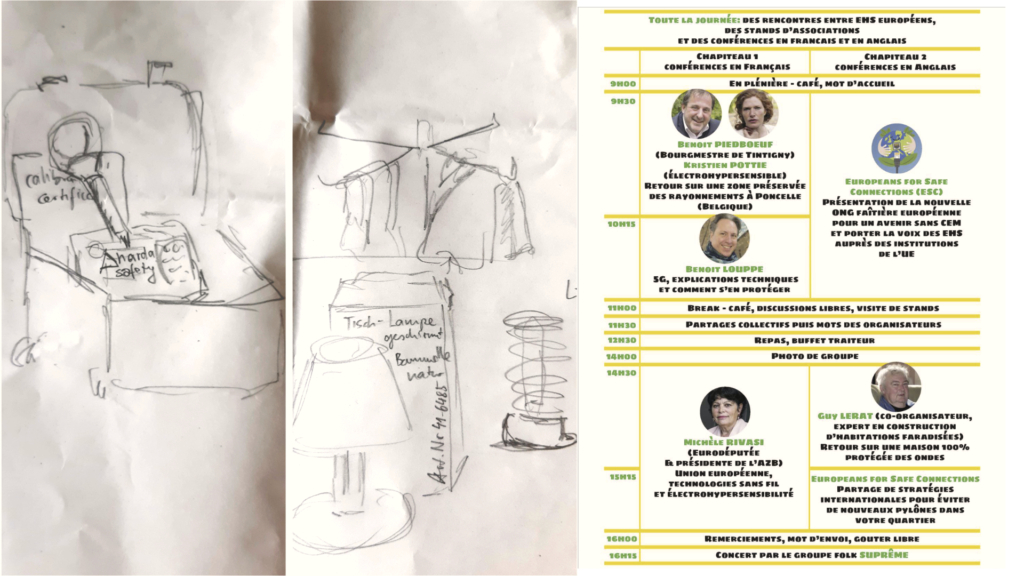
Since I don’t have my mobile phone to take pictures, I make poor drawings of some items on the pavilion tables (left). The programm with presentations in French and English.
In a little garden the organisers and volunteers have put up tents and pavilions. In the bigger tent, the French presentations take place. The English conference stream is in the smaller tent, where we also have lunch, dinner and breakfast. In the two black pavilions, associations and experts display books, protection and detection devices, flyers and information about their works.
Optimistic self-help
When I first met and interviewed the EHS gathering main organiser Eric* in Brussels in April 2023), he told me about his experiences with EHS meetings. Because those meetings aim for participants to share their daily burdens, he sometimes returned more depressed than he had arrived, he said. The European EHS gatherings are therefore organised in a joyful and active spirit. Co-Organiser Corinne* hugs me twice, although we have only just met for the first time. There are other non-EHS people like me at the meeting and I am grateful that I am welcome to participate in my role as a researcher who also speaks to people and institutions that tend to describe EHS as a psychological condition.
The Saturday programme offers a list of presentations of topics relevant to EHS people (see programme). The host of the gathering and a planning and health consultant inform the audience about how to shield themselves and their houses and what to expect from 5G. A member of the Belgian group Ma Vie en Mode Avion gives a public presentation on how to how to convince local authorities to preserve white zones in rural area for EHS persons to settle. A representative of the European Greens working with European Parliament member Michèle Rivasi’s tells the French-speaking audience why it is important to act now – the EU is pursuing its Gigabit strategy. Michèle Rivasi died six months later, which was a great loss for the community.
In the English-speaking tent, the Danish co-organiser of the European Citizen initiative “Stop (((5G))) – Stay Connected but Protected” (Schriver 2021 – https://signstop5g.eu/en) presents the new European umbrella organisation Europeans for Safe Connections (ESC). In the afternoon she speaks about how to prevent the installation of new antenna masts. In the evening, the folk band Suprême is playing live in the open air and people dance and sit together until dark.
A ‘normal’ gathering with ‘normal’ participants?
Looking round during the meeting, I see and feel a gentle buzz. The scene does not convey the vibrant atmosphere that I sometimes experience in conferences (including fomo – the fear of missing out as important research partners might run away before the event closes). In Rièzes, I rather experience a profound sense of mutual respect and thoughtfulness. It seems that people are sensitive not only to electromagnetic waves, but also to each other’s sensibilities. One EHS participant tells me: “If I see a mobile phone on my camping table here, I do not have to worry and don’t get tense because I know, it is Annika’s* mobile phone and she knows and uses it responsibly.”)
Is there anything that distinguishes this EHS gathering from other gatherings, I ask myself? One aspect is surely that people express how happy they are and how special it is to be with other people and especially, to meet people who also suffer from EHS. “Here I am normal,” an EHS women from Germany tells me. “Here the others are not normal” – meaning people like me who use smartphones and are online most of the day. She used to work as a nurse and is now in early retirement.
Moreover, it strikes me that bodies – not only minds – ‘take part’ in this gathering. Bodies are present not only as a means of self-expression, but also as objects of self-care. During the conference, some participants start breathing, stretching or relaxation exercises in front of the tent while still half listening to the presentations. Others are resting in the grass; so is a little black dog that I see lying under changing tables trying to escape the humid heat. Some people tell me they nap in their tents or cars to rest up for socialising. On Saturday evening, quite some people start dancing in the garden during the open-air concert. There is more dancing in small groups and without live music on Sunday.
Of course, there are also less happy aspects that show that these people are not well in a bodily and maybe also psychical sense – maybe less here, but definitely in their daily lives. Some participants make remarks that they can feel that there are still harmful wireless signals causing stress or headaches. (After the meeting, an organiser tells me that one participant was wearing a hearing aid with bluetooth connection without knowing about it. “The entrance screening hadn’t checked rigorously enough, resulting in some symptoms among participants.”)
Some participants seem a bit stressed during plenary sessions in the hot tent. One translator needs to interrupt her translation and an audience member explains that “of course, she cannot concentrate” as there are electric fields (due to electricity) in the tent. Indeed, there are computers, projectors, a video camera. A German woman tells me that electromagnetic radiation is coming from a (not so) nearby building and penetrating the tent – she can feel it. The organiser explains later that “the neighboring farm has a wifi system for surveillance cameras, which could be measured slightly at one end of the house. Some participants are extra vulnerable and could feel it.”
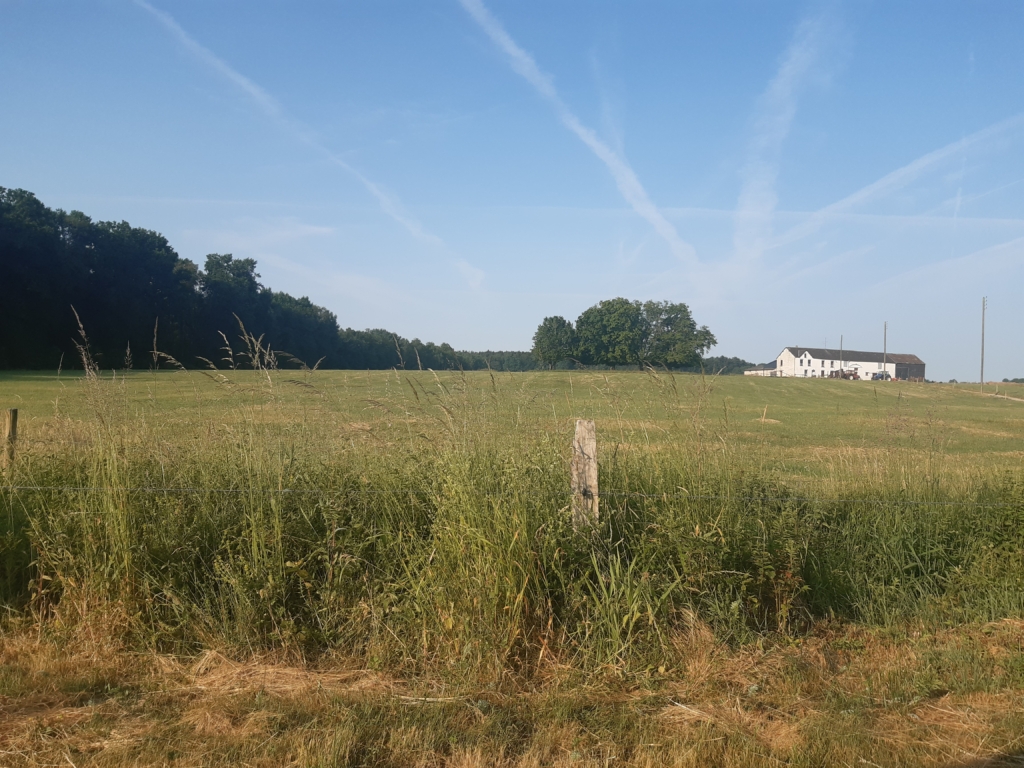
My view from the car on the first morning at the annual EHS meeting.
Overall, I only meet very few people who openly address their suffering. One of them is Vera. She says she’s getting worse every time I meet her over the two days, but still insists that “we’re not talking about illness here.” Indeed, this meeting is organised to convey a joyful spirit and hope. The programme is set up to spur discussions about solutions and to empower EHS people. Conversations about mastering daily life with EHS can take place in private, but there is no plenary format for that. Accordingly, I do not actively look for conversations about symptoms and suffering. “We are normal people,” explains Michael* from Germany. All living bodies are sensitive to EMF, they only have the bad luck to respond more to the waves than others.” This is why EHS people also consider themselves as sentinels.
Breaking out of exile, boosting Europeans for safe connections
Day two of the camp is dedicated to the empowerment of EHS people. It is the first workshop organized by affected groups aiming at changing the situation of EHS people across European borders. The Sunday is dedicated to political EHS exchange and strategizing. In nine working groups we discuss how the loose EHS network gathered in Rièzes could better reach out to the general public and inform or educate non-EHS people about their situation and the danger of electromagnetic waves and wireless communication. The topics are:
– White zones: How to find places and allies to create them, exchange on best-practice
– Children: How to protect children from mobile phone usage, WLAN and hence, EHS
– Education: How to inform people with and without EHS about EHS (labels, info material…)
– PR/Press: How to make the invisible (waves and EHS suffering) visible, e.g. with a logo
– Networking: How to network with ‘heart and body’ and via a collaboration platform
– Law, antennas, lobby: How to act NOW while the EU Gigabit strategy is in the making
– Health/EHS recognition: How to get EHS recognised in the social and health system
– Technical solutions: How to protect oneself – paint, baldachins & technical measures
Another overarching goal is to mobilise support for the new initiative Europeans for safe connections (ESC), which emerged out of the European Citizen initiative “Stop (((5G))) – Stay Connected but Protected”. As a spokesperson points out, the petition not only aimed at collecting the necessary 1 Million signatures, but also to “get a foot into the door of the European Parliament – and this we have achieved!”
To conclude, the outreach plans and activities are fully in line with the Ma Vie en Mode Avion philosophy. The entire programme is documented and recorded on camera. Many people are taking pictures. (I am told that Bluetooth-free video electronic stabilizing equipment is literally impossible to find nowadays). During breaks, the Ma Vie en Mode Avion team is recording interviews with spokespeople of EHS movements and associations. The representative from Michèle Rivasi’s office is putting up the banner of the European Greens in the background of the group picture as they had financially supported the camp.
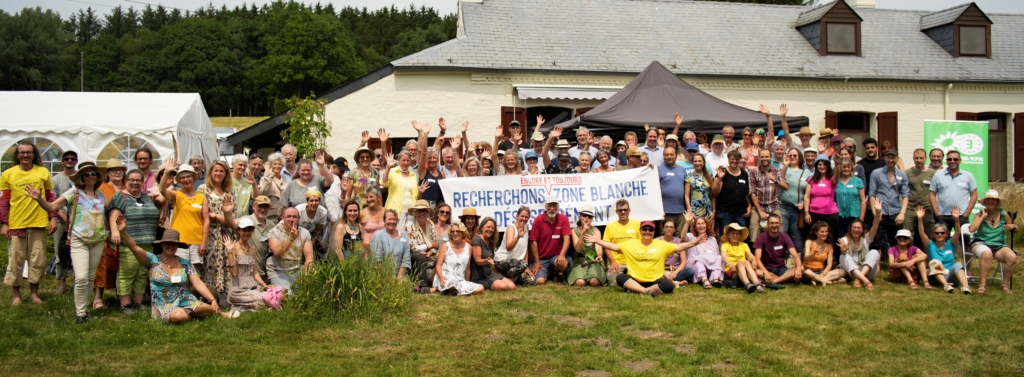
The “family picture” shared by the organisers. Source: Ma Vie en Mode Avion
The Sunday programme closes with a collective clean-up and wrapping-up operation. But before, the participants start deinstalling the tents and the gathering dissolves, the host of the event gives a little farewell speech. He points to the middle of the garden, where over the weekend a waterlily has started to bloom in a little pond full of frogs. “It has not bloomed for a long time”, he says and is very moved. He thinks that is a good omen for the EHS gathering and its cause.
I leave in the late afternoon with my brand-new BMW. I had been right. The car did cause anxieties at the camp site. Luckily, there was a parking area overseeing the campsite where the car did not bother anyone.
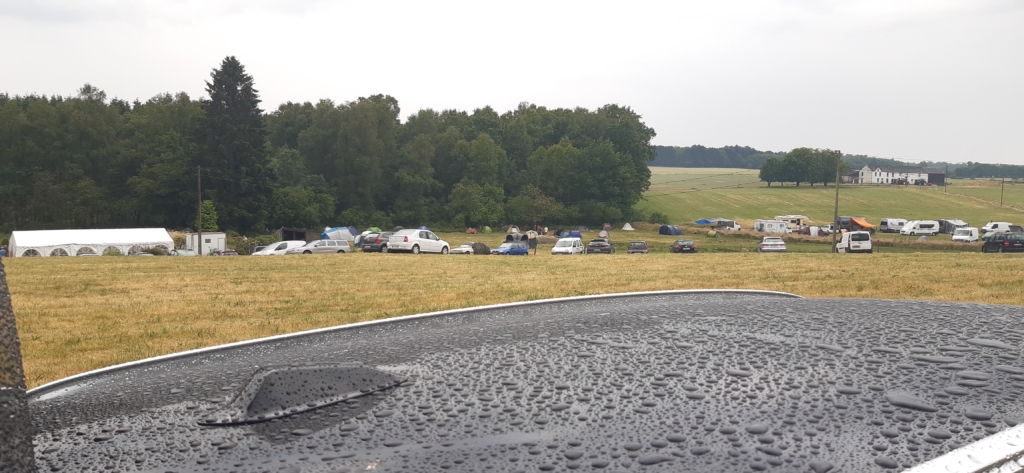
My “Bat mobile” in the parking area – this is how one of the participants called the car.